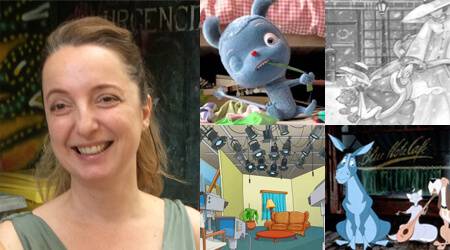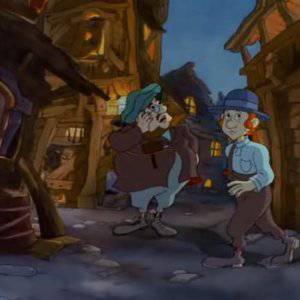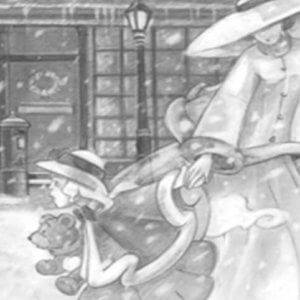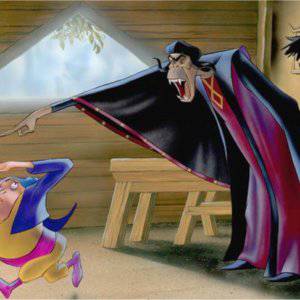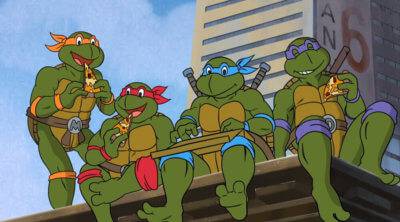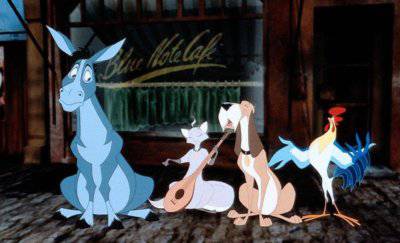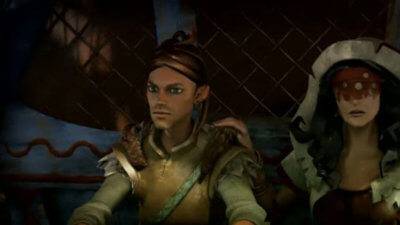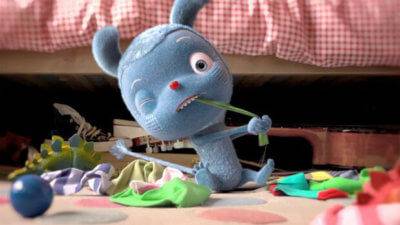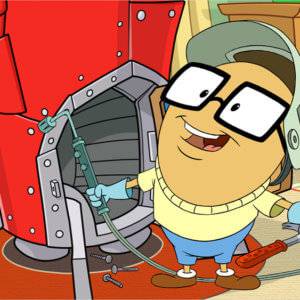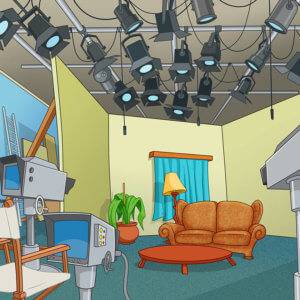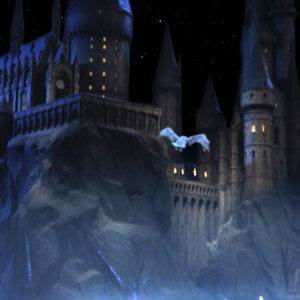Illiana Franklin: A Journey into the Industry
Iliana Franklin is the Art Director at Mediaframe and an Animation tutor at Escape Studios; she has worked in the animation industry for over 30 years, with projects including The Princess and the Pea, The Tale of Despereaux, and A Monkey’s Tale. Find out how she got started in the industry, some of the projects she’s worked on, and her advice for anyone looking to start a career in animation.
What made you decide to go into the creative industries?
I was born into an artistic family, my grandfather and my father are artists, my mother has a degree in literature and drama and she worked as an editor for a specialised magazine. When I was young my father worked at the Children’s Palace in Sofia where he was the Head of Art and as a little girl I used to spend a big part of my early days with my dad at his workplace. This was a unique opportunity for me to grow as an artist; the Children’s Favourite Palace, formerly called Pioneers Palace, had 67 workshops in the field of arts, science, technology and sports. It was a creative laboratory for discovering and developing the talents of thousands of children trained over the years and where many famous Bulgarian celebrities started their careers. In those days I was very young and I had no concept of the real value of the place, I just enjoyed the storytelling time when the Head of the Drama Lab dressed as a fairy and told us stories in the throne room where the walls were covered with frescos with human size figures, representing scenes from classical literature.
- The Real Shlemiel
- The Barrel Organ
- The Castle of the Monkeys
After the story time I would run back to my father in his atelier announcing that the frescos on the throne room walls were boring to watch through the entire story time as they were just the same still images, not like in the books where you can flip the pages and see more pictures. Then, my father would encourage me to create my own illustrations based on these stories. The drawing table was above my head and I needed a chair to step on in order to reach it, so he would lift me up and hand me his pastels and an A1 size cardboard. “Don’t leave any white area”, he used to say, “you must fill the composition with shapes and colours”. So, I was telling him all the stories that I knew of in pictures, I painted lots of princesses in those days and that’s how it all started.
How did you get into the industry?
My art work was well received at the National Academy for Film and Theatre and I was awarded a scholarship in animation which was bound to a professional contract following my graduation, which makes it sound easy, however in those days to get a place in the Academy was not easy at all, there were only a few places for hundreds of applicants.
Presentation is very important factor and I invested all the necessary time and resources to make my portfolio look as good on the outside, as it was inside. The exams went well for me and the most exciting period of my life began with a place in the Academy. I studied not only animation but also drama and acting, drawing, film history and theory, producing and film direction. This experience played an incredibly important role later in my professional life and the contacts that I made then have lasted my entire life. Some of those contacts introduced me to their contacts and I have been introducing them to mine, this is how my professional circle expanded and the opportunities to land on good projects.
As a graduate student I was accredited to attend an international animation film festival in Varna on the coast of Bulgaria. One of the participating companies was Pannonia film from Hungary, the company advertised an animation position in the festival newsletter and I answered the advert. I already had a contract with the film studio in Sofia at the time and part of the conditions of my scholarship was to work for five years on Orville and Cuddles, a series for the BBC; there was a clause prohibiting me from changing career during this five year period. However, I knew that the project was about to stop due to a reform in the Eastern European film industry after the fall of the Berlin wall.
The following five years did not look good for home animation and many of my colleagues were planning to migrate to the west, some of them were already signing contracts with Universal Studios in London to work on “An American Tail: Fievel Goes West (1991)”. Considering the economic climate at the time and the cuts in the film budgets, I started a dialogue with Pannonia film. The founder and director of the subsidiary Kecskemétfilm Kft. Ferenc Mikulás who is also a director of Kecskemét Animation Film Festival offered me a full time contract and relocation. I was delighted to accept the offer as I knew that Hungary in the 1990’s was the second biggest European outsource facility for Hollywood and I was about to enter a very busy period in animation where my skills were highly valued.
My first assignment was animation work on 6 episodes from season 4 of “The Teenage Mutant Ninja Turtles”. I learned Hungarian language very quickly and between 1990 and 2000, I was involved in many of the projects aired in Europe and the US, having different levels of responsibility from key animator to an outsource partner with the lead animation film companies in Hungary at the time.
How long have you been working in the industry?
I have been in animation for over 30 years since 1987 which is nearly a quarter of the history of the animation timeline, which makes me feel really young!
Where do you currently work?
I work as an Art Director at Mediaframe Ltd, and also as an Animation tutor at Escape Studios and lecturer in Animation at the University of Lincoln.
What is your current role?
As a partner and Director at Mediaframe Ltd. I am responsible for the creative decisions behind the projects we work on; I am also involved in the production and business management. As a lecturer and educator, I am responsible for the graduation and the future career of over 100 young people each year, which I think is a huge responsibility and one that I am incredibly happy to have because I am able to pass on the various aspects of my experience from the industry.
What does it take to progress in the industry?
It takes a lot of hard work and discipline to progress in the creative industries; it is a highly competitive industry and it requires developing strong personal, technical, creative, networking and entrepreneurial skills.
What’s your favourite part of your job?
My favourite part of the job is the brainstorming process, it takes some literacy to be able to do this effectively though, the technologies today contribute greatly to the democratization of the creative process. However, to be able to tell a really good story one needs to have some life experience, a good set of values and most importantly, great imagination. So, wherever possible, I always let my mind have space to dream.
Could you tell us about some of the projects you’ve worked on in the past?
I have been fortunate enough to work on an enormous number of projects including commercials, TV series, feature films, games projects, and architectural visualisations. In my early career at Pannonia Film and its subsidiary Kecskemet Film Studio I had the opportunity to work on various TV series including “Mickey and his friends” (1994), “Hungarian Folk Tales”(1992-1996), “Spirou” (1993–1995),, “Carland Cross” (1996), and some feature film projects including “A Monkey’s Tale” (1999) and “The Princess and the Pea” (2002). Through my work with these studios I had the opportunity to meet some great animation directors and producers like Jean-François Laguionie, Juri Norstein, John Halas and Jimmy Murakami.
I also worked for Varga Holding in Budapest with the amazing producer Andarsz Erkel and the directors Ginger Gibbons, Alexey Alexeev, and Igor Kovaliov. I produced animation for studios including Sullivan Bluth Studios, Klasky Chupo, Film Roman, and some of the titles include The Simpsons (Do The Bartman) (1990), Baby Blues (2000), Kipper, Percy the Park Keeper, Mr Men, Mr. Bean, The Thief and the Cobbler. At Loon Land Studio in Budapest I was involved in several TV and feature film productions including “Les belles histoires de Pomme d’Api” (1995), “Babar: King of the Elephants” (1999) “Aaron’s Magic Village” (1995) directed by Albert Hanan Kaminski and “The Fearless Four” (1997), where I had the opportunity to work with the production designer Carlos Grangel, who also designed for The Prince of Egypt, El Dorado, Spirit, Corpse Bride, Kung Fu Panda, Pirates, Hotel Transylvania. Carlos Grangel inspired my interest in production design and pre-production, his unique style heavily influenced industry design trends at the time. I decided to change direction and in 2000 I signed a contract with Animagic Studio in Madrid where I was invited to work as a storyboard artist with the amazing Marcos Mateu-Mestre on his feature film project “The Three Wise Men”. This presented a great opportunity for me to work with some great artists in the feature film industry – Sergio Paez, an incredibly talented storyboard artist who left Spain to join Lucas Arts directing the storyboarding for The Star Wars: Clone Wars; Marcos Mateu-Mestre went to work for Dreamworks and is known for his work on The Prince of Egypt and Eldorado.
At Animagic Studio I also met Paul Franklin, an artist trained by the Don Bluth School in Dublin who had worked at Disney Paris and London and had been involved with the Tigger Movie and Tarzan. Paul and I got married and moved to the UK with the idea to settle and start a family. The new millennium has brought to the market the digital technologies and the face of the industry was changing, so we had to adapt to the new digital environment. My daughter was born in the meantime, so I started studying and transferring my skills into 3D and continued to work in the animation industry as a Concept Artist, Cinematic Artist and Visualisation Artist for several big studios, including Microsoft Games Studios, Universal Studios, Lionhead, Foster+Partners and Squint Opera, designing for some great projects including the Nanjing Grand Theatreand the Fable game franchise. For “Fable the Journey” I was creating the cinematic and in-game story direction including the trailer for E3; I was also involved in the pre-production concept art for “The Tale of Despereaux”, and the character, environment design and storyboarding for “Okido” development at Squint Opera, to name just a few.
Since August 2007 I have been a partner and Art Director at Mediaframe Studios. All the work that I did during my career is very valuable to me, each new project always presents a new challenge and throughout the process of overcoming the challenges I always learn something new. For example after many years working with anthropomorphic characters “The Fearless Four” was as a breath of fresh air for me, the script was a modern interpretation of the original Grimm Brothers story; working on this project I learned everything about the animal’s anatomy and motion. These studies continued later on with the next feature film project “A Monkey’s Tale” where we had to learn how monkeys behave. “The Three Wise Men” employed a pipeline similar to the one at Disney Studio where the directors worked previously and this was also a great experience for me particularly in storyboarding. My favourite projects however, are the ones that created in my own studio as they opened the opportunity for me to learn more about the animation business.
What are you working on at the moment?
At the moment I am working on a pitch for a new children’s TV series which we hope to have completed in the spring of 2019; I’m afraid I can’t say much more about it than that at this stage, but it’s very exciting and we have some amazing people attached to the project.
Would you be able to give an insight into how you approached your most recent project and the steps you took to complete the project?
The most recent project is the one we are currently developing and I am involved with as an author and producer. We started with stories that were developed in house and then went on to finding money for the project, putting together a creative team with a common vision; this was really exciting as it drew together a lot of people I had worked with in the past, as well as some unexpected interest from other people that we are delighted to have attached to the project. Then I moved on to directing the pitch production and exploring routes to market for the project. It’s a different market to the one that I began my career in and there are so many directions that can be pursued for monetising a production; you are always learning and get to be quite dynamic in the way you approach financing and structure deals.
- Couch Potatoes TV Pitch
- Coouch Potatoe TV Pitch
- Harry Potter Theme Park Universal
I feel very privileged at this stage of my career to be involved in so many areas of the production process and no two days are ever the same. The work I do and the great people I get to meet inspire me every day.
Is there anything you would have done differently?
I would have pursued a degree in Law because there are so many areas of the Animation business where it is important to protect the rights of your work and protect yourself contractually and I think having a good overview in this area is essential.
What does it take to land your first job?
A well presented portfolio, determination, self confidence and a little bit of luck. Networking and building up professional contacts is also important, going to professional events such as festivals, job markets, conferences, and social events. But it does take energy and ultimately it will be about your determination and the quality of your work.
What are your top tips for building your network of contacts?
In the past it was about connecting with colleagues and building strong network with the professional circle, however with the huge prominence of social media nowadays, I think it’s more relevant to keep a professional social profile, don’t cover it with “selfies” and holiday snaps. Nurture conversations on social media with people you want to connect with and disseminate posts that have professional relevance. Maintaining a professional online profile on the social media is so important as it leaves a fingerprint and we must be very careful how we shape it and who do we connect with.
Any other advice you’d give to budding female creatives?
Despite the fact that things are changing for the better in terms of women getting more opportunities in the industry, it is still a very male dominated profession. Although most men in the profession are gentlemen, there can be challenges and women can feel a little outnumbered at times. But the way to make a presence felt in a positive way is to always be professional, determined to learn as much as possible from everyone and if the person next to you, man or woman, is doing 10 hours per day make sure you are doing 11. Don’t play the “girly card” as it doesn’t really matter if you are a female or a male creative, those that work the hardest and act the most professionally tend to move forward.



